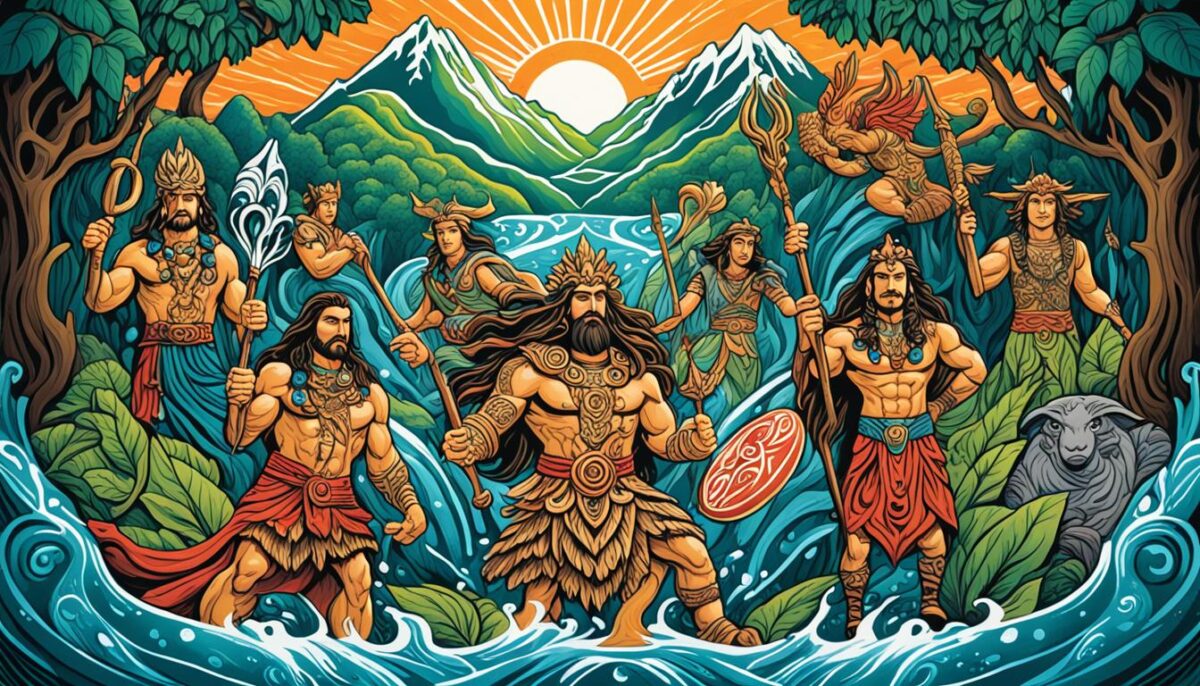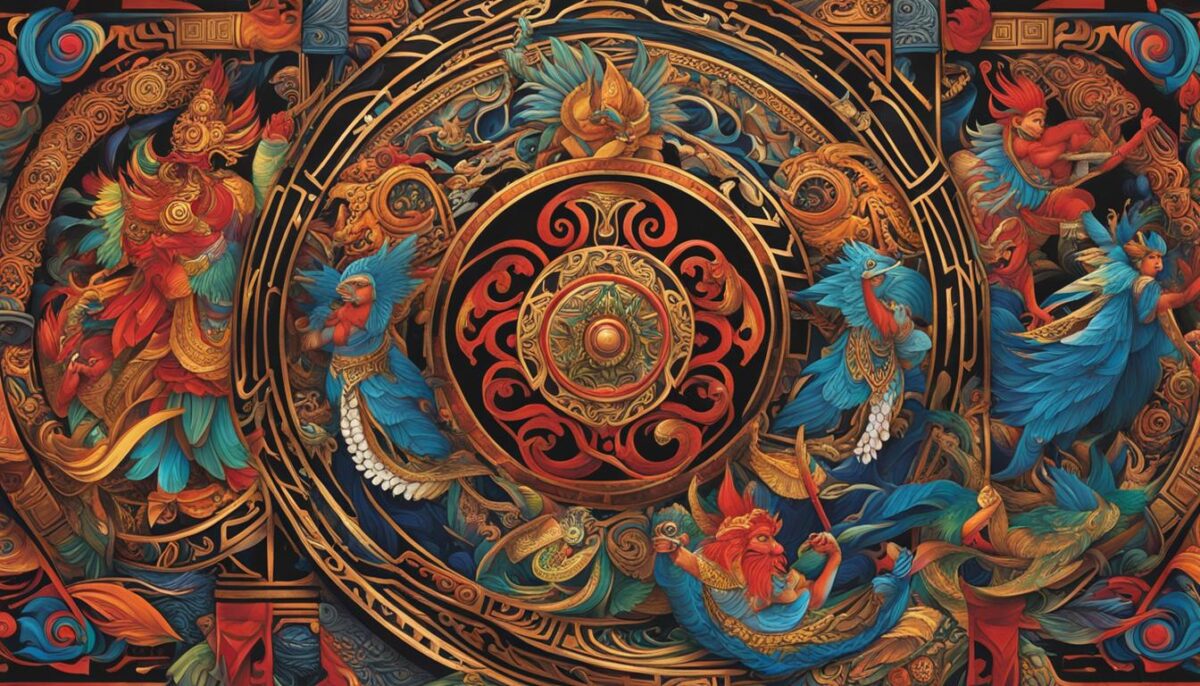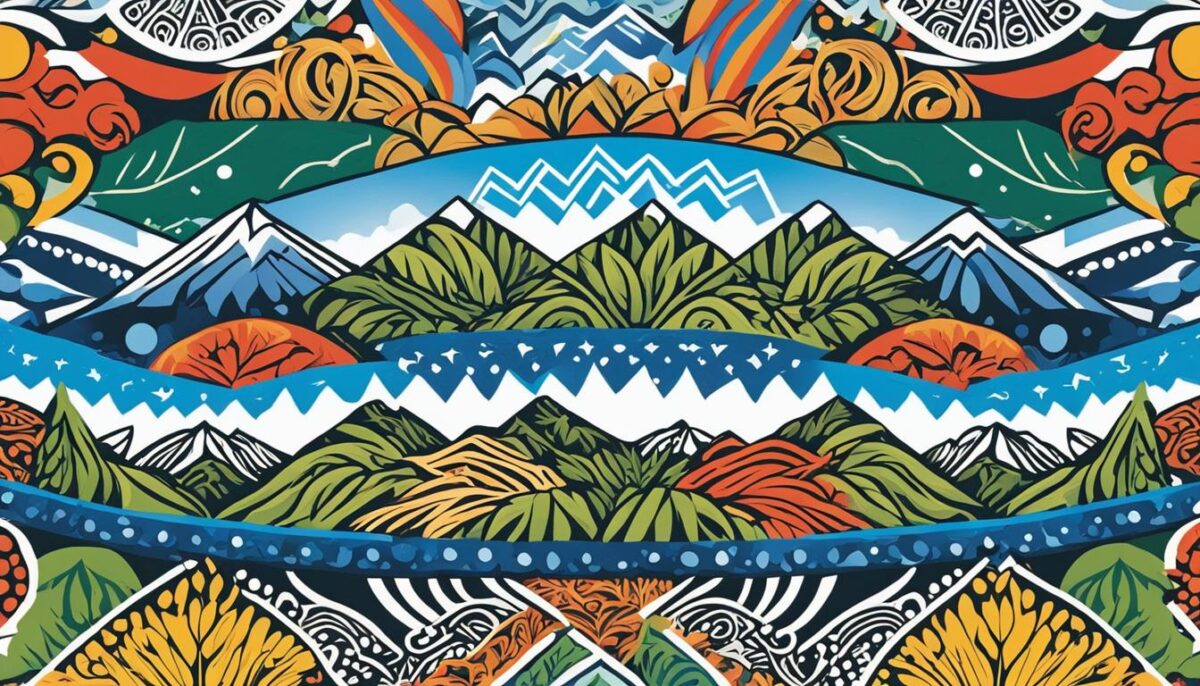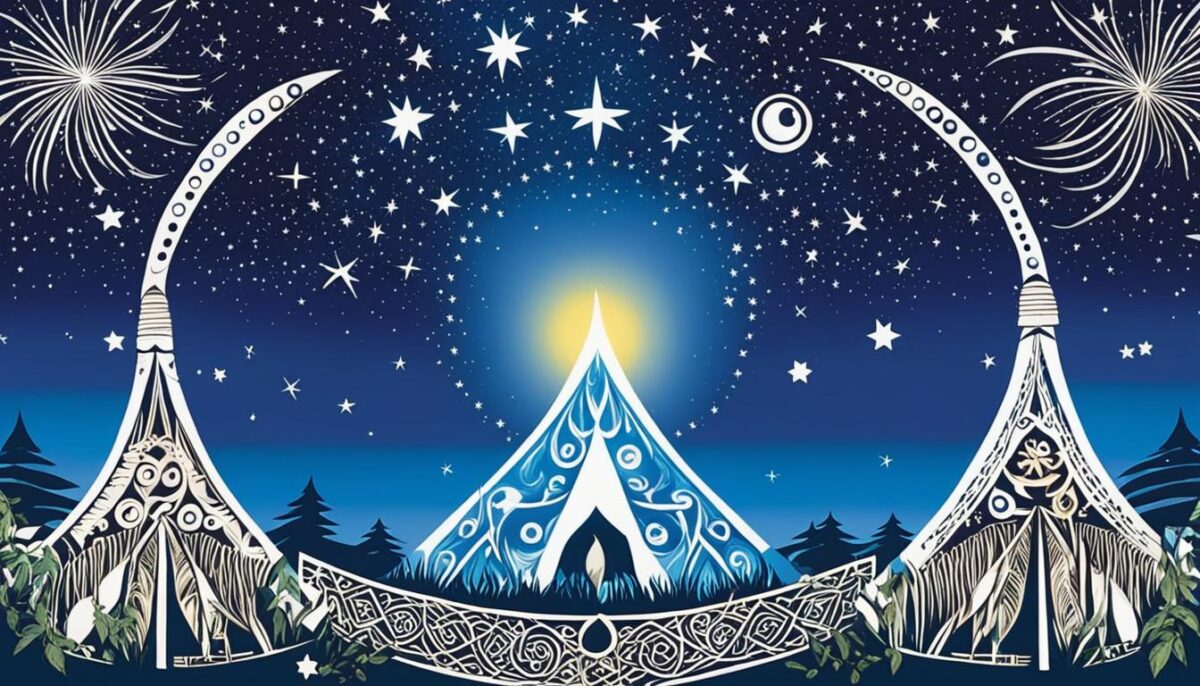Welcome to our exploration of the fascinating pantheon of the 7 Māori Gods, an integral part of New Zealand’s indigenous culture. As we dive into the rich mythology of the Māori people, we will uncover the significance of these deities in Māori spirituality and their roles in shaping the Māori worldview.
Throughout history, myths and legends have provided insight into the origins of the world and the divine beings who govern it. The Māori creation myth reveals the story of Ranginui, the sky father, and Papatūānuku, the earth mother, whose intertwining bodies birthed the gods and the world as we know it. These deities hold immense importance in Māori cosmology, serving as the foundation of the Māori understanding of the universe.
In our journey through Māori mythology, we will encounter a diverse array of gods and goddesses, each with their unique roles and domains. Tāne Mahuta, the god of forests, is revered for his connection to nature and the abundance it provides. Tangaroa, the god of the sea, commands the tides and is an essential figure in Māori seafaring traditions. These deities, alongside others such as Tūmatauenga, the god of war, and Hine-nui-te-pō, the goddess of death, play pivotal roles in Māori culture and spiritual practices.
As we conclude our exploration, we will examine the enduring legacy of Māori gods in contemporary Māori culture. Their influence can be seen in various aspects, including art, storytelling, and spirituality. By preserving and celebrating these ancient traditions, the Māori people keep the wisdom and mythology of the gods alive, ensuring the continuation of their rich cultural heritage.
Join us on this captivating journey through Māori mythology, where we will unravel the secrets of the 7 Māori Gods and gain a deeper appreciation for New Zealand’s indigenous culture.

Create an image featuring the 7 Māori gods in a natural setting, surrounded by lush trees and flowing water. Each god should be depicted with distinct physical attributes that represent their unique power and character. Use bold colors and intricate patterns to convey a sense of ancient mythology. Show the gods interacting with each other in a respectful and harmonious way, reflecting the values of Māori culture. Capture the essence of these powerful deities without relying on text or dialogue.
The Creation Myth and Ranginui and Papatūānuku
In Māori cosmology, the Creation Myth is a captivating story that explains the origins of the world and all living beings. Central to this myth are Ranginui, the sky father, and Papatūānuku, the earth mother.
Ranginui and Papatūānuku were locked in a tight embrace, their bodies intertwined. This closeness resulted in darkness and limited space for their children to thrive. The gods, in their wisdom, decided to separate Ranginui from Papatūānuku, creating space and allowing their offspring to flourish.
“Ranginui and Papatūānuku, held each other tightly and had many children, but they needed room to grow and flourish…”
This moment of separation gave birth to other significant gods and elements of the world. For example, Tāne Mahuta, the god of forests, used all his strength to separate his parents and create the sky and the land. Tangaroa, the god of the sea, emerged from the waters released by Ranginui.
This Creation Myth is not only a beautiful story but also a reflection of Māori cosmology. It emphasizes the interconnectedness of all things and the balance between the spiritual and physical realms.
The Significance of Ranginui and Papatūānuku
Ranginui represents the expanse of the sky, while Papatūānuku symbolizes the earth. Together, they created the foundations of the world, providing a nurturing environment for life to flourish. Ranginui’s separation from Papatūānuku allowed for the existence of other gods, who each played a vital role in shaping different aspects of the natural world.
An Overview of Māori Cosmology
Māori cosmology is rooted in the interconnectedness of all things and an intimate relationship with the natural world. It emphasizes the balance between the realms of gods and humans, highlighting the importance of respecting and protecting the environment.
Key Gods and Their Roles
| God | Role |
|---|---|
| Tāne Mahuta | God of forests and birds |
| Tangaroa | God of the sea |
| Tūmatauenga | God of war |
| Hine-nui-te-pō | Goddess of death |
These are just a few examples of the gods within Māori cosmology. Each deity has a unique role and domain, contributing to the intricate tapestry of Māori spirituality and mythology.
Key Māori Gods and Their Roles
In Māori mythology, there are seven key Māori gods who hold significant roles and domains within the spiritual realm. Each deity possesses unique attributes and powers that contribute to the overall Māori cosmology. Let’s explore some of these influential gods and the roles they play in Māori culture.
Tāne Mahuta – God of Forests
Tāne Mahuta, the god of forests, is revered as the progenitor of birds and trees. He is known as the guardian and protector of the natural world, being responsible for the creation of forests and their inhabitants. Tāne Mahuta symbolizes the connection between humans and nature, emphasizing the importance of preserving and respecting the environment.
Tangaroa – God of the Sea
Tangaroa, the god of the sea, holds dominion over all marine life and bodies of water. He is associated with fertility, abundance, and the ebb and flow of tides. Tangaroa’s influence extends beyond the oceans, as he is also closely tied to rainfall and weather patterns. Worshipped by fishermen and voyagers, Tangaroa represents the vastness and power of the sea.
Tūmatauenga – God of War
Tūmatauenga, the god of war, embodies courage, strength, and skill in battle. He is revered as a fierce warrior and teaches the Māori people the techniques and strategies needed for warfare. Tūmatauenga’s presence reminds them of the need for perseverance and resilience in times of conflict.
Hine-nui-te-pō – Goddess of Death
Hine-nui-te-pō, the goddess of death, guides souls to the afterlife and oversees the realm of the deceased. She is seen as a benevolent figure who welcomes and cares for those who have passed away. Hine-nui-te-pō symbolizes the natural cycle of life and death, emphasizing the importance of accepting the inevitability of mortality.
These are just a few examples of the key Māori gods and their roles within Māori mythology. Each deity contributes to the rich tapestry of Māori culture, providing valuable teachings and insights into the human experience and our connection with the natural and spiritual worlds.

Create an image featuring the seven key Māori gods, each depicted with their respective roles and attributes. Show them interacting with each other in a vibrant and dynamic scene that captures the essence of their power and presence. Use bold colors and intricate details to bring these mythical figures to life.
The Legacy of Māori Gods in Contemporary Culture
The rich mythology of the Māori gods continues to thrive in contemporary Māori culture, weaving its way through various aspects of modern society. These ancient deities hold a significant place in the hearts and minds of the Māori people, their influence extending beyond spirituality and into art, storytelling, and daily life.
Māori gods, such as Tāne Mahuta and Tangaroa, are celebrated and revered as symbols of indigenous spirituality. Their wisdom and teachings are passed down through generations, providing a guiding light for Māori communities in navigating the complexities of the modern world.
One can witness the legacy of these gods in the vibrant and diverse art forms of Māori culture. From intricate carvings and tattoos to stunning paintings and sculptures, contemporary Māori artists draw inspiration from the stories and symbolism of the Māori pantheon. Through their creations, these artists pay homage to the gods and keep their presence alive.
Furthermore, the mythology of Māori gods is a driving force behind the captivating storytelling traditions of the Māori people. Through oral narratives, songs, and dances, Māori communities continue to share the tales of their gods, ensuring their longevity and preserving their teachings for future generations. These stories connect the past with the present, imparting valuable lessons and fostering a deeper understanding of Māori culture and spirituality.


